 |
 |
Photos of the DayFebruary 2 - St. Barth, French West Indies 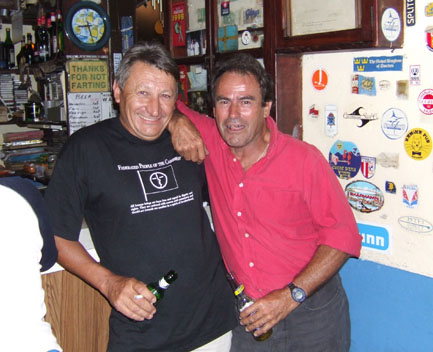 Lucky on the left, Yvan on the right, are old warriors remembering great times. Both complied with the request on the wall of Le Select to not fart. Photo ©2007 Latitude 38 Publishing Co., Inc. Today's Photo of the Day, of Lucky Poupon and Yvan Fauconnier in the Le Select Bar, shows why we chose to spend most of our Caribbean time in at St. Barth, as opposed to Guadeloupe, St. Kitts, Nevis, the Grenadines or anywhere else. The island, and the humble Le Select Bar, simply attracts the great yachts and great sailors of the world. Those of you who have been sailing a long time will recall Yvan as one of the pioneering French sailors of the '70s and '80s, who broke all kinds of sailing barriers and brought unheard of excitement to the sport. For example, his entry for the '76 OSTAR was the 128-ft ITT Oceanic, better known by her previous name of Vendredi 13 (Friday the 13th). Plagued by even more problems than Alain Colas aboard the 236-ft Club Mediterranée, Yvan had to be towed to Newfoundland, with the skipper of another disabled entry, by a Russian tug. In between doing many other transatlantic races with Michael Birch, Yvan entered the 53-ft Umupro Jardin, the first tri with really large amas, in the '82 Route du Rhum transatlantic race. While he finished eighth, he did much better in the '84 OSTAR, the big race of the era. Sailing the same boat, Yvan took overall honors for the best elapsed time. There was some controversy, however, as Philippe Poupon, Lucky's brother, actually finished first, but Fauconnier was given 16 hours credit for standing by countryman Philippe Jeantot, who had flipped his cat Credit Agricole. Yvan naturally became a hero in sail-crazed France, but since he's more comfortable in a storm on the ocean than in front of the press and with sponsors, he didn't capitalize on his victory as others might have. Yvan's last competitive event was the France to St. Barth Figaro in '98, with his then 26-year-old daughter Karine. His daughter had spent several years of her childhood aboard Vendredi 13 doing charters in the Caribbean with her dad, and in the process met and sailed with all the great French sailors of the time. She subsequently went on to race the 60-ft ORMA tri Sergio Tacchini singlehanded across the Atlantic several times, and with crew won the most recent Quebec, Canada, to St. Malo, France, race. Dad naturally worried about her when she did those races "because those ORMA trimarans are really crazy." In fact, Yvan had to help organize a rescue of Karine and her boat when Tacchini was badly damaged, along with many other tris, in a solo transatlantic event. Now that Karine has a nine-month-old child, she's limiting her competitive sailing to an all-women's D-35 cat, which will race one design on the lakes of Switzerland. One of her crew will be the wife of Ernesto 'Alinghi' Bertarelli. After giving up competitive sailing, Yvan and a partner began looking for a strong, reliable and reasonably fast cruising boat to take to the more remote and interesting parts of the globe. Ultimately, they decided to buy an Ocean 71 ketch. In fact, he called us eight years ago, thinking that Latitude might still own the Ocean 71 Big O. Fauconnier and his partner ended up buying Darwin Sound, the Ocean 71 that Al and Irene Whitney had chartered out of Vancouver and around the Pacific for 15 years. Although the ketch is more than 35 years old, Fauconnier says she's been a solid, safe passage-maker. The safe is important because twice he has sailed the Southern Ocean from New Zealand to Cape Horn. In all, he's covered 70,000 miles in seven years. He's about to cross the Atlantic again and is hoping to later explore the coast of Newfoundland. 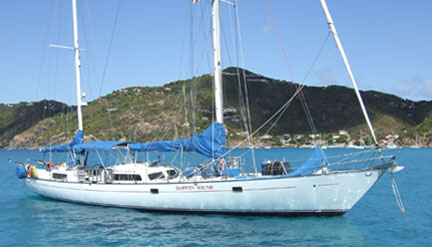 Darwin Sound, after traveling all over the world for the past seven years, enjoys a short break in the warm and blue waters of Gustavia Harbor. If anybody knows the whereabouts of Al and Irene, we hope you'll alert them to this photo. Photos Latitude/Richard Photo ©2007 Latitude 38 Publishing Co., Inc. In another West Coast connection, Fauconnier reports that famous Italian around-the-world singlehanders Giovanni Soldini and Vittorio Malingri, who also spend time flipping ORMA 60 trimarans, bought St. Elmo's Fire, the Ocean 71 that was based in Sausalito and then La Paz for many years. They used her to do charters in the San Blas Islands, but have since taken her across to the Med. We'll have more on Yvan in the March issue of Latitude 38. Until then, you can visit his boat's Web site at www.croisieres-antilles-fauconnier.com. As for Lucky Poupon, we'll have more on him later, as next year he's going to be doing another France to St. Barth doublehanded race. He's been warming up for that by doing long distance doublehanded races, such as Calais to Istanbul, with Florence Arthaud, another pioneering French sailor. - latitude / rs |
El Niño Weakening as Cruisers Prepare for SoPac CrossingFebruary 2 - Puerto Vallarta, Mexico Some cruisers who plan to cross from the Mexican mainland to the South Pacific this spring (the so-called 'Pacific Puddle Jump') have expressed concerns about the potential effects of this year's El Niño conditions. By definition, this warming of Pacific equatorial waters typically occurs every three to seven years, resulting in shifts in 'normal' weather patterns - whatever 'normal' means these days. However, NOAA (National Oceanographic and Atmospheric Administration) scientists report that water temperatures in the tropics have tended toward historical norms in recent weeks. According to Vernon Kousky, research meteorologist at the NOAA Climate Prediction Center, "A return to neutral conditions in the tropical Pacific is expected this spring."
Note the subtle differences in water temperature between December 13, above, and January 30, below. Less red indicates cooler temperatures. Graphics Courtesy NOAA Meanwhile, Bob Bechler of the Gulfstar 44 Sisiutl, who has crossed to French Polynesia several times in the past five years, chimed in on the subject from Puerto Vallarta: "El Niño, La Niña. . . the weather is always different from year to year, and as I always say 'It is what it is. . .' Do not make plans of whether or not to cross depending on long range weather forecasts. Just be prepared to deal with conditions that you will find when you get out there. The most common comment we heard from locals was, "You should have been here last year, we never see weather like we are having this year. . ." Look for a two-part report on this year's Puddle Jump fleet in the April and May editions of Latitude 38. - latitude / aet |
February Latitude Hits the DocksFebruary 2 - San Francisco Bay Area  Photo Latitude/Annie Photo ©2007 Latitude 38 Publishing Co., Inc. The February issue of Latitude 38 made its way around the Bay by truck yesterday and was shipped out to destinations further afield. Pick yours up in all the usual places. Not available in your area? Consider subscribing by mail or e-Book. A gift subscription would make a great Valentine's Day present for your sailing sweetheart! |
Jim Gray Disappearance Still a MysteryFebruary 2 - San Francisco Despite an extensive search effort that involved U.S. Coast Guard resources combined with private sector satellite imagery analysis, the disappearance of renowned computer scientist Dr. Jim Gray is still a complete mystery. As has been widely reported, Gray singlehanded his C&C 40 Tenacious out to the Farallon Islands Sunday to scatter his mother's ashes and has not been heard from since. Having searched over 132,000 square miles of open ocean and coastline over a four-day period, the Coast Guard finally called off its efforts late yesterday afternoon. However, Gray's family, friends and tech industry associates continue to search by conventional means such as via small planes, as well as by scrutinizing Google Earth satellite map imagery. Nevertheless, at this writing not a single clue has emerged as to the 63-year-old sailor's disappearance. Capt. David Swatland, deputy sector commander for the CG's Northern California area was quoted as saying, "I personally don't remember this ever happening." The Guard's massive search extended more than 300 miles offshore, north past the Oregon border and south to the Channel Islands. - latitude / aet |
Which Is the 'Biggest'? You Decide.February 2 - Office of Sailing Measurement Standards, RI In the last couple of 'Lectronics, we've discussed, with incomplete information, the very important issue of which is the biggest privately-owned sailing yacht in the world, Tom Perkins' Belvedere-based Maltese Falcon, launched last year in Turkey, or Barry Diller's Beverly Hills/New York-based Eos, launched a few months ago from Lurssen in Germany. We've now got the facts, but it's still going to be up to you to decide which is the 'biggest'. Depending on how you interpret it, 'biggest' could mean the longest overall, including bowsprits, if any, or the longest on deck, or longest waterline, or the greatest displacement. 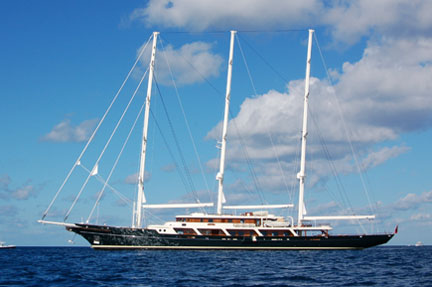 Eos Photo Latitude/Richard Photo ©2007 Latitude 38 Publishing Co., Inc. The facts are as follows: Based on the above information, Eos is longer by benefit of her bowsprit and has a slightly larger beam, but Falcon is longer on deck and considerably longer on the waterline. So they are both the biggest privately-owned yacht in the world in at least two respects. But having consulted with sailing experts from around the world at the Le Select Bar here in St. Barth, including many who have extensive experience on boats with bowsprits and overhanging booms, they say the real measure of the size of a sailing yacht is the length on deck and the waterline length. In most cases, bowsprits and booms aren't included in a boat's 'real length', and long bow and transom overhangs don't count for much. By those measures, Maltese Falcon would still be the largest privately-owned sailing yacht in the world. - latitude / rs 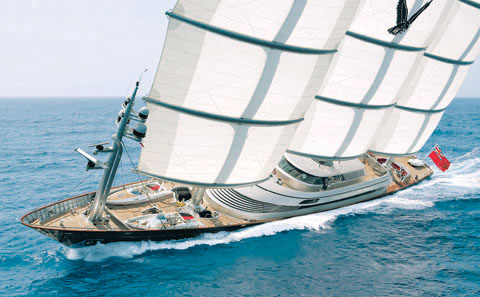 Maltese Falcon Photo Giuliano Sargentini Photo ©2007 Latitude 38 Publishing Co., Inc. |
America's Cup ArrestFebruary 2 - Valencia, Spain Reports are coming out of Spain that the Basque separatist group ETA was planning an attack in Valencia this spring during the America's Cup. ETA member Iker Aguirre Bernadal was arrested Monday on his way to Valencia where, police claim, he was to gather information about Cup ceremonies and events, the infrastructure of the host city's port, and hotels where officials and important guests would be staying. The judge who ordered Aguirre's arrest says that when he was taken into custody, Aguirre carried plans about making explosives, 3,000 Euros, and several false identity cards. He was arrested on provisional charges of belonging to a terrorist group, conspiring to commit murder, and forging documents. America's Cup Management, the company tasked with managing the 32nd America's Cup event, has remained publicly silent on the arrest, as have most Cup challengers. On Tuesday, New Zealand media quoted Emirates Team New Zealand head Grant Dalton as saying that the information was still speculative and he had heard nothing official from authorities. "We became aware of this threat from ETA just over the last day or two, but it's always been on our mind," he said. "They're probably not after us, they're after the big teams, but we have a fairly stringent crisis plan in place. We expect America's Cup Management will brief the team on this incident if necessary." - latitude / ss 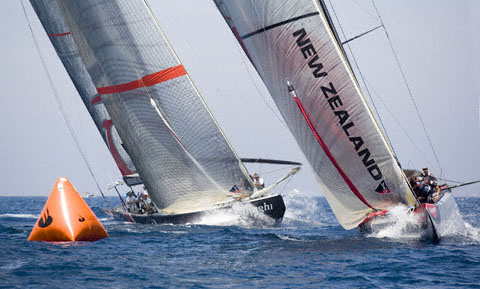 Emirates Team New Zealand facing off against Alinghi in during Act 12 in Valencia last summer. Photo Carlo Borlenghi/ACM 2006 Photo ©2007 Latitude 38 Publishing Co., Inc. |